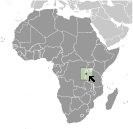World Atlas: Burundi. On this page you can see the map, country flag and many detailed information about the people, history and economy of Burundi.

Here you can find online selected information about the geography, inhabitants, government, economy and history of Burundi. Included are selected statistics, an overview map and the detailed map of Burundi. But let's start with the flag of Burundi here:
Burundi - Overview:
What you should know about Burundi? Let's start with this: Burundi is a small country in East Africa bordered by Tanzania, Rwanda, and Lake Tanganyika. Burundi gained its independence from Belgium in 1962. Much of its history has been turbulent, and Burundi's first democratically elected president was assassinated in October 1993 after only 100 days in office. The internationally brokered Arusha Agreement ended the 1993-2005 civil war, paving the way for a new constitution and 2005 elections. Pierre Nkurunziza was elected president in 2005 and 2010 and again in a controversial election in 2015. Burundi continues to face many political and economic challenges.
Geography of Burundi
 Where on the globe is Burundi? The location of this country is Central Africa, east of the Democratic Republic of the Congo, west of Tanzania. Total area of Burundi is 27,830 sq km, of which 25,680 sq km is land. So this is not a large country. How could we describe the terrain of the country? This way: hilly and mountainous, dropping to a plateau in east, some plains. The lowest point of Burundi is Lake Tanganyika 772 m, the highest point Heha 2,670 m. And the climate is equatorial; high plateau with considerable altitude variation (772 m to 2,670 m above sea level); average annual temperature varies with altitude from 23 to 17 degrees Celsius but is generally moderate as the average altitude is about 1,700 m; average annual rainfall is about 150 cm; two wet seasons (February to May and September to November), and two dry seasons (June to August and December to January).
Where on the globe is Burundi? The location of this country is Central Africa, east of the Democratic Republic of the Congo, west of Tanzania. Total area of Burundi is 27,830 sq km, of which 25,680 sq km is land. So this is not a large country. How could we describe the terrain of the country? This way: hilly and mountainous, dropping to a plateau in east, some plains. The lowest point of Burundi is Lake Tanganyika 772 m, the highest point Heha 2,670 m. And the climate is equatorial; high plateau with considerable altitude variation (772 m to 2,670 m above sea level); average annual temperature varies with altitude from 23 to 17 degrees Celsius but is generally moderate as the average altitude is about 1,700 m; average annual rainfall is about 150 cm; two wet seasons (February to May and September to November), and two dry seasons (June to August and December to January).
Inhabitants of Burundi
Let's take a look how many people live in Burundi. The number is: 11,466,756. So this is not very populous country. Who lives here? Hutu (Bantu) 85%, Tutsi (Hamitic) 14%, Twa (Pygmy) 1%, Europeans 3,000, South Asians 2,000. What are the languages in Burundi? Kirundi 29.7% (official), Kirundi and other language 9.1%, French (official) and French and other language 0.3%, Swahili and Swahili and other language 0.2% (along Lake Tanganyika and in the Bujumbura area), English (official) and English and other language 0.06%, more than 2 languages 3.7%, unspecified 56.9%. And the religions: Roman Catholic 62.1%, Protestant 23.9% (includes Adventist 2.3% and other Protestant 21.6%), Muslim 2.5%, other 3.6%, unspecified 7.9% (2008 est.). How old are the people in average? 17 years. We have to add that this number is the median - so one half of the people is older than this, one half is younger. And what is their life expectancy (at birth)? This: 60.9 years. Where the people live in Burundi? Here: one of Africa's most densely populated countries; concentrations tend to be in the north and along the northern shore of Lake Tanganyika in the west; most people live on farms near areas of fertile volcanic soil. The major urban areas of Burundi are: Bujumbura (capital) 751,000 (2015).
Government and Economy of Burundi
The capital of Burundi is Bujumbura and the government type presidential republic. Let's take a look at the administrative divisions - 18 provinces; Bubanza, Bujumbura Mairie, Bujumbura Rural, Bururi, Cankuzo, Cibitoke, Gitega, Karuzi, Kayanza, Kirundo, Makamba, Muramvya, Muyinga, Mwaro, Ngozi, Rumonge, Rutana, Ruyigi. Regarding the economy of Burundi, important industrial products are light consumer goods (sugar, shoes, soap, beer); cement, assembly of imported components; public works construction; food processing (fruits). Important agricultural products are coffee, cotton, tea, corn, beans, sorghum, sweet potatoes, bananas, cassava (manioc, tapioca); beef, milk, hides. The most important export commodities are coffee, tea, sugar, cotton, hides and the most important export partners are Democratic Republic of the Congo 30.6%, UAE 15.7%, Kenya 14.5%, Rwanda 7.2% (2016). The most important import commodities are capital goods, petroleum products, foodstuffs and the most important import partners are China 13.3%, India 13%, Tanzania 8.6%, Saudi Arabia 7.9%, Kenya 7.5%, UAE 5.2%, Uganda 5% (2016). How rich is Burundi and how rich are people in this country? The most important number here is GDP per capita (PPP): $800 (2017 est.). This is a very low number. Let's add that this means Gross Domestic Product per person, which is recalculated with respect to the relative cost of local goods and services. And one more important number - population below poverty line: 64.6% (2014 est.).